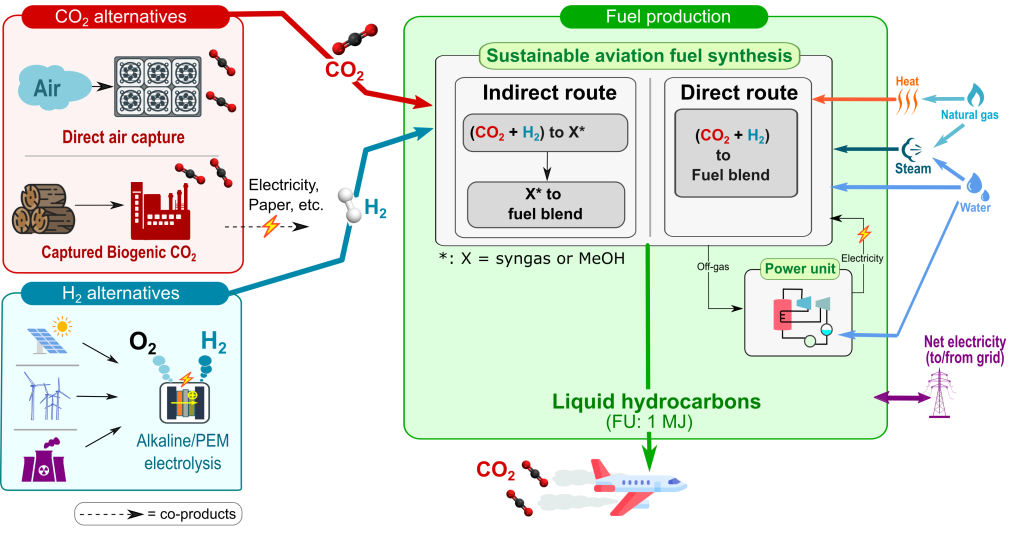Circular Economy and Me – Issue 12

Circularity of carbon: how can we make aviation greener? By Dr Andrea Bernardi
The aviation industry accounts for approximately 3% of the total global CO2 emissions. Despite this seemingly small contribution, decarbonizing the aviation sector poses significant challenges. While electric vehicles are gaining popularity in ground transportation, airplanes require a higher energy density than current battery technology can provide, especially for long-haul flights that contribute to 80% of the total emissions. Furthermore, the demand for air travel is expected to increase, potentially outpacing the efficiency improvements in new aircraft. Despite these challenges, organizations like the International Air Transport Association (IATA) and several countries, including the UK, aspire to achieve net-zero emissions in aviation by 2050 (Department of Transport, 2022).
A key enabler for net-zero aviation is sustainable aviation fuel (SAF), a “drop-in” fuel that can be used in existing engines and achieve at least 50% reduction of global warming potential on a life-cycle basis (with the EU regulation setting the threshold at 65%). Beyond carbon reduction, SAF has the potential to improve air quality by reducing the emissions of pollutants that contribute to smog and respiratory issues. While SAF holds immense promise, scaling up production to meet the demands of the aviation industry remains a challenge.
SAF can be derived from various renewable sources, including biomass, waste cooking oil, and CO2. My research specifically focuses on the latter, where I compare alternative synthetic fuels produced by combining CO2 from biogenic or atmospheric sources with hydrogen generated through electrolysis powered by low-emission or renewable electricity (Bernardi et al. 2023). My analysis aims at estimating the cost of SAF as well as its environmental performances, not only in terms of CO2 emissions but considering a comprehensive set of environmental aspects, including water consumption, land use, etc. In fact, something that needs to be avoided or minimised is the so-called burden shifting, i.e. reducing one environmental impact but increasing others.

Life cycle analysis (LCA) involves a systematic examination of potential environmental impacts throughout the entire life cycle of a product, from raw material procurement to the utilization phase. A comprehensive LCA, evaluating a wide range of environmental impacts, aids in identifying potential burden shifting and offers recommendations on which process alternative is preferable. It also highlights environmental hotspots that require further improvement.
My results indicates that synthetic fuels can achieve up to an 80% reduction in CO2 emissions with limited burden shifting, making them a promising option for decarbonizing the aviation sector. However, the question remains: what are the obstacles hindering the widespread deployment of SAF?
The two main bottlenecks are resource availability and cost (Royal Society, 2023). Large quantities of low carbon electricity are needed for the H2 production, as well as large scale deployment of carbon capture and the development of an infrastructure to transport the CO2 to the SAF production facility. For example, to meet the SAF production target set for 2030 in the UK strategy (10% of total jet fuel) approximately 50 TWh of low-carbon electricity would be required, which represent 20-30% of the new offshore wind capacity planned by 2030 (Department for Energy Security and Net Zero, 2023).
Another significant challenge for SAF is cost. Currently, SAF production from CO2 and electrolytic H2 has a cost 6 to 10 times higher than conventional kerosene. While economies of scale in CO2 and H2 production can contribute to cost reduction, policy interventions are likely necessary to incentivize and boost the utilization of SAF in the aviation sector.
References:
- Bernardi et al., 2023. “Enviro-economic assessment of sustainable aviation fuel production from direct CO2 hydrogenation”, Computer Aided Chemical Engineering, 52, 2345-2350
- Department of Transport, 2022. “Jet Zero Strategy: delivering net zero aviation by 2050”, https://www.gov.uk/government/publications/jet-zero-strategy-delivering-net-zero-aviation-by-2050
- Department for Energy Security and Net Zero, 2023, “Offshore wind net zero investment roadmap”, https://www.gov.uk/government/publications/offshore-wind-net-zero-investment-roadmap
- The Royal Society, 2023. “Net zero aviation fuels – resource requirements and environmental impacts policy briefing”, https://royalsociety.org/topics-policy/projects/low-carbon-energy-programme/net-zero-aviation-fuels/